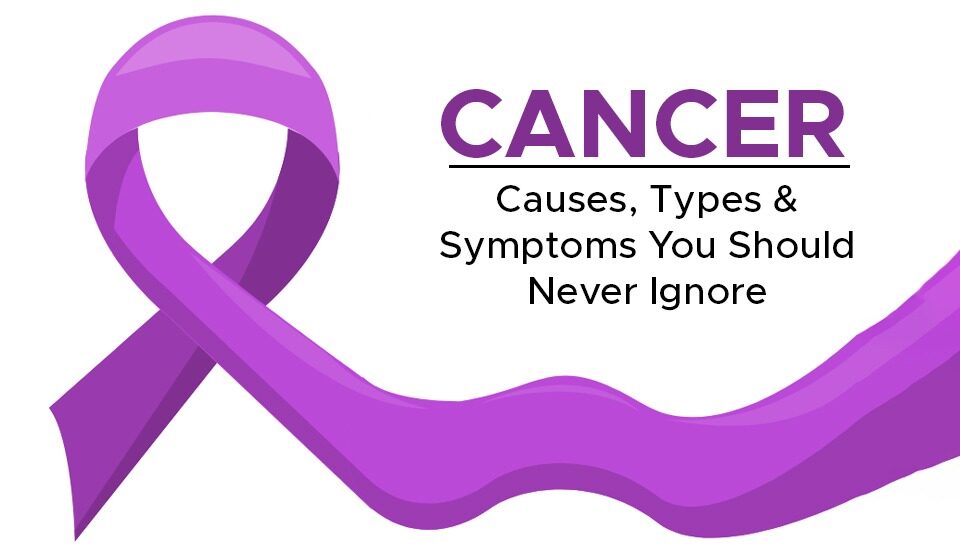Did you know that 9.81% of males and 9.42% of females in India have a risk of developing cancer before the age of 75 years?
Cancer can impact almost any organ or tissue in the body. One of the defining features of cancer is the abnormal, rapid growth of cells that invade other cells and spread to other tissues and organs. There are different types of cancers based on the region in which they begin to appear.
Let’s check some of the different types of cancers that are the most frequent in the Indian population, ranked in terms of the number of cases.
- Breast Cancer
- Cervical Cancer
- Oral Cavity Cancer
- Lung Cancer
- Colorectal Cancer
Source: http://cancerindia.org.in/cancer-factsheet/
The question foremost on everyone’s mind is ‘what’s the biggest cause of cancer?’ A person gets exposed to a lot of things from the surroundings that makes them prone to developing cancer. Another risk factor is the exposure to carcinogenic-substances that a person encounters at the home, workplace, and even outdoors. Certain daily habits can also cause cancer.
Here are some of the habits linked to cancer:
- Improper stress management makes an individual prone to cancer and other diseases like high blood pressure and fluctuating heart rate. There is currently mixed evidence on stress directly causing cancer.
- A sedentary lifestyle can increase the risk of colon, endometrial, and lung cancer.
- Poor food choices like eating processed foods that contain unhealthy fats and other substances may lead to the growth of cancerous cells in the body.
- Drinking less water increases the accumulation of toxic substances which can contribute to cancer of the bladder.
- The outcome of uncontrolled drinking may heighten the chances of developing melanoma, prostate, and pancreatic cancers.
- Smoking
- Increased use of paraben-based products.
Just as getting regular health checkups is mandatory, equally important is to pay attention to every possible sign and symptom that can lead to cancer. We must look out for signs that our body gives us.
Sometimes, cancer does not give any signs to indicate its existence.
Check out the underlying symptoms that may occur with cancer:
Persistent cough and blood in the mucus
Cough that lasts longer than a month and, accompanied by blood in the mucus, could represent infections. These could be symptoms of lung, head, or neck cancer.
Irregular or change in bowel habits
Factors like diet and fluid intake play a role in bowel habits. However, it is vital to note that cancer occasionally exhibits continuous diarrhoea. Also, doctors have suspected thin stools to be associated with colon cancer. Any change in bowel habits other than dietary changes requires immediate attention.
Indigestion
If you are experiencing problems while swallowing foods or indigestion, it could indicate stomach, throat, or oesophagal cancer.
Changes in the skin
Sometimes there are changes in the skin that could indicate signs of cancer. For instance, if the skin appears yellow or red, it can signal skin cancer. Other than this, sores that take a lot of time to heal must never be ignored. If there are any changes in the size, colour, shape of your moles, freckles or warts, give immediate attention to them. .
Changes in appetite
Bloating or difficulty in eating can occur in the case of ovarian cancer.
Changes in the mouth
If you see any red or white patches in the tongue or mouth, it could tell a tale about oral cancers. Numbness in the mouth and bleeding in lips could be a sign that one must notice.
Anaemia
If one is suffering from anaemia (low red blood cells’ count), it could be indicative of certain cancers like leukaemia and lymphoma.
Changes in the breast
Any abnormal lumps in the breast, sudden changes in breast size, or discharge from the nipples could be a sign of cancer.
Trouble Urinating
Cancers that are common in men are prostate, lung or colorectal. Moreover, if any pain or lump appears in the scrotum, it could indicate testicular cancer.
Reference:
* Source: http://cancerindia.org.in/cancer-statistics/
The views and opinions expressed, and assumptions & analysis presented in this content piece are those of the author(s) and do not necessarily reflect the official policy or position of any other agency, organization, employer or company. The information, including but not limited to, text, graphics, images and other material contained on this website are for informational purposes only. The purpose of this website is to promote broad consumer understanding and knowledge of various health topics. It is not intended to be a substitute for professional medical advice, diagnosis or treatment. Always seek the advice of your physician or other qualified health care provider with any questions you may have regarding a medical condition or treatment and before undertaking a new health care regimen, and never disregard professional medical advice or delay in seeking it because of something you have read on this website.




